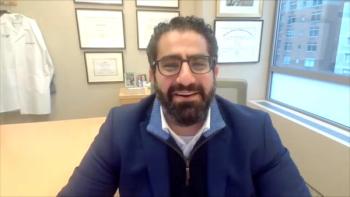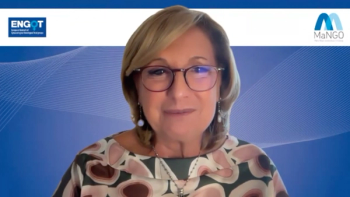
A Current Look at the Oncology Care Model
Transcript:
Bruce Feinberg, DO: Hello, and thank you for joining this American Journal of Managed Care® program titled, “Immunotherapy in the Oncology Care Model.” The CMS Oncology Care Model, or OCM, is a 5-year model focused on increasing the coordination of oncology care, holding providers accountable for financial- and performance-based care of chemotherapy. The model has been implemented for over 2 years, so we’ll get insight from our expert panel on the progress thus far.
I’m Dr. Bruce Feinberg, vice president and chief medical officer at Cardinal Health Specialty Solutions in Dublin, Ohio.
Participating today on our distinguished panel are: Susan Ash-Lee, senior director of clinical services at Cancer Support Community in Denver, Colorado; Dr Richard D. Carvajal, director of experimental therapeutics and director of the melanoma service in the Department of Medicine at Columbia University Irving Medical Center in New York, New York; Ted Okon, executive director of Community Oncology Alliance in Washington, DC; and Dr Kavita Patel, vice president of Johns Hopkins Health System in Washington, DC.
Thank you so much for joining us, and let’s begin.
Bruce Feinberg, DO: I think a great place to begin may be to level set on the OCM. I really believe that despite everybody, at this point, 3 years out believing they know the OCM, I think there’s a lot that still remains either unknown or maybe is just misinformed. But, I would say, even in my perspective, and I thought I was knowledgeable, the first 2 years were MEOS [monthly enhanced oncology services] payments. It felt like as a prior large practice doctor, it would have been a no-brainer. You make investments in your practice to meet the requirements, but year 3 was going to be the tricky one. At year 3, you get a performance review, and you might actually have dollars at risk. That’s why it’s a 1-sided risk. But it doesn’t sound like in that performance review there was any risk. It was, “You’re getting your full fee-for-service. You’re getting your MEOS payment.” But, you may not get a bonus which sounds as if it’s not an at-risk program but rather more of a shared-savings program. Kavita, you get to start this off. You’re a policy expert. What was the intent at the design and when it was launched? Has that changed, or were many of us just misinformed of what was going to transpire?
Kavita K. Patel, MD, MS: I think that intent, when it was launched, was to really have a full specialty care model that was not completely inpatient centered, to be quite honest. There was really no and still really is to date no specialty payment, alternative payment model in the Medicare program that is largely outpatient based. Certainly, the relationship between the inpatient and outpatient can get blurry, but all the programs to date have been more primary care centered in the outpatient setting, like accountable care organizations; or in the inpatient setting, they are pretty heavily focused on episodic care bundles. This was really, and some people do characterize this, a bundled payment in the sense that there’s a 6-month time horizon. But we all know, and those of us who are taking care of patients on a day-to-day basis really understand, that cancer patients don’t come in discrete 6-month aliquots.
The original intent was to 1, launch a specialty payment model. Number 2, to your point about risk, was for oncologists be put at risk over a 5-year time horizon, for what we’re affectionately or not affectionately calling total cost of care. What we’re learning, and you put a bit of a provocative statement in there. It’s true for year 3. We actually are only scratching the surface of what we know. But I would just say for future conversations, today we should talk about what it is that even the policy makers are learning because of this 2-plus-year experiment. Certainly we’re seeing CMS and CMMI [Center for Medicare & Medicaid Innovation], and then maybe even more importantly private payers saying, “OK, that’s what the government is doing. We’re going to take it, tweak it, and do something a little bit more our style.” The theme of value-based payment in oncology got started full force with the oncology care model, just because of the sheer volume in Medicare. But, the news is that no matter what the politics or what kind of attitudes, that value-based payment is here to stay.
Bruce Feinberg, DO: All right. That was a good overview. It didn’t get into some of the nitty-gritty that I was looking for.
Kavita K. Patel, MD, MS: All right. Someone else can do it.
Bruce Feinberg, DO: Ted, you deal with these practices all the time. Take me back 3 years. Were my impressions the impressions of the practice leaders that you’re dealing with and practice managers that you’re dealing with? Did they think that year 3 was when they were going to have to potentially pay the piper?
Ted Okon, MBA: I think so, Bruce. I think a lot of practices went into it not knowing exactly what was going to happen but realizing that basically they were going to be getting MEOS payments at some point in time. They did this sort of shared-savings aspect. They would get a report on it. I think they also realized, but it was in the distant horizon 3 years ago, that at some point in time, they were going to have to decide: Do they go at risk, meaning 2-sided risk, where they really have to pay? That’s what is going to be faced in this October.
But, I think the big deal is that they knew they had to make investments. They knew that they were getting payments. I think some practices realized—especially those that were sort of medical oncology home products, I mean programs on the commercial side—that they literally had to change their operations and what they did. Frankly, some practices went into it, and they just kept on practicing the way they were. It was really a little bit of a hodgepodge. Of course, some of the practices initially sort of dropped out, so there were some dropouts early.
I think that now everybody is looking at it and saying, “I’m facing 2-sided risk, what does that mean?” I think the other thing is practices are looking and saying, “What next?” As Kavita said, you have practices that are participating in different commercial programs. They’re looking at Medicare and saying, “What happens next, especially since I’ve made this big investment in people and in infrastructure systems,” which they have in most cases. Now it’s a bit unknown. It’s interesting looking back 3 years, 4 years, and then looking at it where it is now.
Newsletter
Stay ahead of policy, cost, and value—subscribe to AJMC for expert insights at the intersection of clinical care and health economics.














































